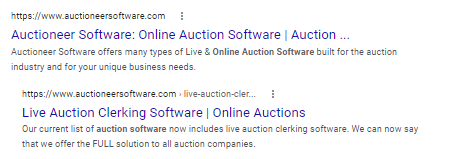
5 Components of SEO That Will Never Change
There are about five components of SEO that will always stay the same despite Google algorithm trends and updates. Knowing and understanding these elements will provide you with successful best practices for your online presence.
But first, let’s understand exactly what SEO is.
What is SEO?
SEO, also known as search engine optimization, simply enhances your online presence through search engines like Google, Bing, or Yahoo! These are avenues where your audience searches keywords that are related to your business, hoping to find someone to fix their problem.
Selecting the right keywords will guide your online marketing strategy and, ultimately, lead to higher search engine rankings and conversions.
Below, we have outlined five components of SEO in detail. When you understand and practice these components, you will steadily see an increase in quality website traffic and leads.
The 5 Components of SEO You Should Start Doing Today
Helpful and Informative Content
Creating a website is the first step in establishing an online presence. However, it doesn’t begin ranking just because it is live. Your business website must be optimized and crawlable by search engines to see any real results.
In the late 2000’s when SEO first took off, it was a common practice to “keyword stuff” pages. Keyword stuffing is when a website overloads a page with keywords or numbers to try to manipulate its site rankings in a SERP (search engine results page).
In today’s SEO world, search engines have gotten much smarter and evolved. Practicing keyword stuffing now will get your site flagged as a spammer, and search engine spiders are programmed to ignore these sites that are guilty of bad SEO tactics. Check out Good SEO vs. Bad SEO for more information on these practices to avoid.
Therefore, keyword research is so important to implement correctly. Additionally, this is why creating helpful and informative content will always prevail in SEO. Readability contributes to your SEO score, which rates your content on how clear it is to your target audience.
This element is important for all owned content, such as blogs, videos, podcasts, downloadable one-sheets, and more.
Meta Description and SEO Title
A meta description is the information about the webpage that appears in the SERP below the title/URL of your page. An SEO title is the title of your page that also appears in the search results.

When you create a meta description that is compelling and concise with a clear CTA at the end, it will improve the CTR of your organic search results. This means more of the people who see your page in the SERP will click through and land on your webpage. Even if your ranking doesn’t change, you can expect more traffic to your website.
The same goes for SEO titles, too. Your SEO title should include your target keyword at the beginning and be no more than 60 characters. They should also be catchy and easy to read, and therefore, you must find the sweet spot between SEO and readability.
Check out How to Write SEO Headlines for some more information.
Connect With Us
Categories
- Blogging
- Branding
- Content Management System (CMS)
- Content Marketing
- Custom Website Development
- E-Commerce
- Events
- Facebook Advertising
- Google Indexing
- Holiday
- Logo Design
- Marketing
- Mobile Friendly Website
- Mobile Responsive Design
- New Website
- Newsletter
- Online Directories
- Online Marketing
- Reputation Management
- Search Engine Marketing
- Search Engine Optimization
- Search Engines
- Social Media
- Social Media Advertising
- Submit URL to Google
- Website Design
- Website Maintenance
- Website Security
- WordPress Website Development
Recent Posts
Archives
Internal Links, Integration, External Link Building and Backlinks
Have you ever noticed that when you read a blog or webpage, some hyperlinks lead to other relevant information on the same website? More than likely, you have,e and you’ve even clicked on a few to expand your reading.
Internal Links
Internal links are those hyperlinks that point to other pages on the same website. The internal links help search engines understand the most important pages on your website.
The search engines consider pages with relevant internal links to be more valuable than those with fewer links. Integrating internal links is a simple way to improve traffic and time spent on your website.
External Links
In contrast, external links are hyperlinks that point to web pages that are outside of your domain. These provide your readers with outside references that enhance your website’s authority and credibility, which is also a factor that contributes to quality content.
Backlinks
Backlinks are when another website links back to your website. The quality of a backlink is dependent on the online reputation and authority score of the original website. Backlinks are crucial to have because they signal to Google that other websites find your content valuable. To be successful with this, you will need to develop a backlink portfolio.
This tactic is time-consuming with continuous outreach, but it is an extremely important factor in your link strategy for SEO.
To learn more, check out Why Having a Strong Backlink Strategy is Critical for Optimal SEO.
Google My Business/Reviews
Local SEO is the process of optimizing your website to appear for your target location. Search engines, especially Google, are getting better at displaying location-based search results on more generic search inquiries.
When you think about local SEO, think about how many times you’ve searched “car wash near me” or “oil change near me”. Google provided you with the closest businesses near you based on your location for your convenience.
This type of search does have limitations, for example, when you search for “marketing agency”, it will return mostly national results.
Incorporating location-specific keywords is extremely powerful for this reason. Include the following in your keyword selections:
- City
- State
- General Area
Additionally, Google My Business (GMB) is a free, easy tool for businesses to manage their Google presence, including on Search and Maps. To optimize your GMB profile, make sure the following information is correct:
- Business Hours
- Contact Information
- Location(s)
- Area(s) your business serves
- Your service and/or product offerings
This is a simple and powerful way to optimize your local online presence while avoiding falling into the “keyword stuffing” trap.
Check out What is Local SEO for more information.
User Experience
Recently, user experience (UX) has become more and more important for SEO. When a website is slow, laggy, and has excessing pop-ups, Google will consider it to be spammy and therefore, a lower authority score. If your website provides its users with a bad user experience than most likely it won’t rank in the top 10 of the search results.
UX will always remain important for SEO because it helps searchers find (and remain) on your website, converts traffic into hot leads, and keeps your customers coming back to you.
Components of SEO that Will Never Go Out of Style
When you implement your SEO strategy with these 5 basic elements in mind, you will certainly see a steady increase in both conversions and traffic over time. Reminder that SEO does NOT happen overnight, this is a long-term investment that when done correctly will provide you with some amazing results.
We all know and see the benefits of Paid Advertising, when done correctly. But laying the foundation of solid organic SEO will likely to remain important for business for years to come. An even more strategic avenue is to incorporate not just one or the other BUT implement both Organic SEO and Paid Advertising to see REAL results.
Ready To Stay Driving Better Results with Your SEO Strategy? Contact Us Today to Speak With Us!
